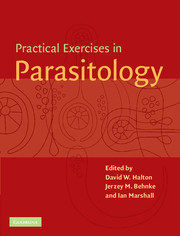Book contents
- Frontmatter
- Contents
- List of contributors
- Preface
- General advice
- 1 Observational Exercises on Parasites
- 2 Ecology
- 3 Physiology and Biochemistry
- 4 Pathology and Immunology
- 4.1 Encapsulation of foreign matter (not-self) by earthworms
- 4.2 Opsonisation of trypanosomes
- 4.3 Production and screening of monoclonal antibodies against Leishmania promastigotes
- 4.4 Pathological effects of Mesocestoides corti and Schistosoma mansoni
- 4.5 Quantification of lymphocyte populations in the spleen and thymus
- 4.6 Use of basic indirect ELISA for the detection of antibodies produced by experimental immunisation
- 4.7 SDS PAGE and Western blotting for the detection of antibodies produced by experimental immunisation
- 5 Chemotherapy
- 6 Molecular Parasitology
- 7 Behaviour
- Appendix 1 Reagent index
- Appendix 2 UK suppliers
- Appendix 3 US suppliers
- Index
4.7 - SDS PAGE and Western blotting for the detection of antibodies produced by experimental immunisation
Published online by Cambridge University Press: 05 June 2012
- Frontmatter
- Contents
- List of contributors
- Preface
- General advice
- 1 Observational Exercises on Parasites
- 2 Ecology
- 3 Physiology and Biochemistry
- 4 Pathology and Immunology
- 4.1 Encapsulation of foreign matter (not-self) by earthworms
- 4.2 Opsonisation of trypanosomes
- 4.3 Production and screening of monoclonal antibodies against Leishmania promastigotes
- 4.4 Pathological effects of Mesocestoides corti and Schistosoma mansoni
- 4.5 Quantification of lymphocyte populations in the spleen and thymus
- 4.6 Use of basic indirect ELISA for the detection of antibodies produced by experimental immunisation
- 4.7 SDS PAGE and Western blotting for the detection of antibodies produced by experimental immunisation
- 5 Chemotherapy
- 6 Molecular Parasitology
- 7 Behaviour
- Appendix 1 Reagent index
- Appendix 2 UK suppliers
- Appendix 3 US suppliers
- Index
Summary
Aims and objectives
This exercise is designed to demonstrate:
SDS PAGE for the resolution of proteins into their component parts.
Western blotting for the detection of immunogenic antigens, using serum from experimentally immunised animals.
Introduction
Sodium dodecyl sulphate polyacrylamide gel electrophoresis (SDS PAGE) and Western blotting are both widely used techniques in parasitology. SDS PAGE is used to separate mixtures of proteins into individual protein bands by dissolving them in SDS (which is a mild detergent) and reducing with 2-mercaptoethanol. The protein solution is then loaded onto an acrylamide gel. When an electric field is applied to the gel, the proteins are separated according to their molecular mass, smaller peptides moving further down the gel. These protein bands can then be stained to visualise their position and therefore their molecular weight can be determined. In this exercise, however, we will not be staining the protein bands but transferring them to nitrocellulose paper where they will be immobilised. These antigens can then be probed by antibodies in order to determine the immunogenic components of the protein.
For the purposes of this practical an anti-serum to the homogenate of Heligosomoides polygyrus has been prepared (see Exercise 4.6). H. polygyrus is a trichostrongyloid parasite that was first introduced as an experimental infection in laboratory mice over 50 years ago, and has since been used extensively as an animal parasite model system. Primary infections are maintained for up to 10 months.
- Type
- Chapter
- Information
- Practical Exercises in Parasitology , pp. 293 - 302Publisher: Cambridge University PressPrint publication year: 2001



